Lexington CommUNITY’s 20th annual MLK Day Celebration
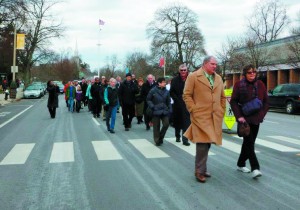
By Laurie Atwater
Each year Lexington CommUNITY sponsors a march and program to celebrate Martin Luther King Day. This committee has been working together in Lexington for many years to bring issues of diversity and social justice to the forefront of community discourse. Committee members Claudia Lach, Larry Link, Charles Martin, Brenda Prusak, Yukari Watanabe Scott, Jill Smilow, Sam Zales and Helen Cohen always deliver a provacative and thoughtful presentation to honor this important national figure.
On Sunday, January 20th, Lexington CommUNITY presented its 20th annual community commemoration of Martin Luther King Day. The theme: Diversity in Lexington’s Schools: Looking Back, Looking Forward. Along with community members, the event was attended by Superintendent of Schools Paul Ash, School Committee member Margaret Coppe and Selectman Hank Manz.
According to CommUNITY member Jill Smilow, the committee chose this theme as part of the overarching 300th anniversary in Lexington to celebrate the public schools and the progress that they have made on diversity issues. Smilow, who began working with No Place for Hate years ago, has seen great progress in Lexington over time. From Lexington’s early embrace of the METCO (Metropolitan Council for Education Opportunity) program, to solidarity with same-sex couples and their families in the Lexington schools, Lexington has sought to be a welcoming place for all. Although Smilow acknowledges that there is much work to be done, she said that the CommUNITY committee really wanted to “showcase the fact that there is a lot being done and a lot has been accomplished in the schools.”
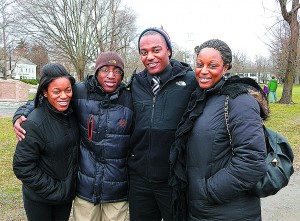
Smilow noted that the MLK Day panel was made up of educators who have received the Sharyn Wong-Chan and Sara Harrington Diversity Award. The award is presented each year by Lexington’s Diversity Task Force to educators that embrace and promote cultural diversity in the schools. Smilow credits the Chinese American Association of Lexington (CAAL) for underwriting the award each year which comes with a cash prize. Participating on the Sunday panel were Ann Kim Tenhor, a technology specialist at LPS elementary schools, Lexington High School guidance counselor Melissa Buttaro and former dean William Cole, who is now a social studies teacher at LHS. Also participating in the special program was Malik Alfred, a 2012 METCO Scholar.
THE DEMOGRAPHICS OF DIVERSITY
After a performance by the Bowman School fifth grade chorus, conducted by music specialist Martha Rodgers, Assistant Superintendent of LPS Human Resources Bob Harris opened the program, he told the audience a fact they may have been surprising—Dr. King actually visited Lexington in 1963 and spoke to a group of Lexington residents.
Harris went on to discuss the changing demographics of the Lexington public schools, saying that in the past few decades, the percentage of minority students in the Lexington Public Schools has almost doubled. In 1963 LHS was almost 100% white. Lexington High School is now 62% White, 33% Asian and 5% Black. The increase in diversity has come predominantly from an influx of Asians—Chinese, Indians, and Koreans.
Lexington is an affluent suburb that has been inching its way forward from insular to decidedly more inclusive. We’re still predominately white—just not as white as we were 10 years ago.
Each era has seen changes that are peculiar to the times. In our modern era, the largest influx of new residents came post WWII with the development of the highway system and the new found wealth of the working class. Affordable entry level homes in Lexington and surrounding suburbs made it possible for working class families and to escape the city for the green grass of the burbs. At the same time academics moved to Lexington and settled in progressive neighborhoods like Moon Hill, Peacock Farms and Five Fields, and this trend continued bringing with it an increasing focus on education and the schools in town. With these new residents came a measure of economic diversity that was enjoyed in Lexington throughout the sixties and seventies, but little non-Caucasian ethnic diversity
After the Immigration Reform Act of 1965 made is easier for Asians to immigrate to the U.S., the Asian population began slowly to grow in Lexington. The explosion in biotech, sciences and high tech have attracted many Asian immigrants to Boston for its universities and high-tech jobs, which has converged with Lexington’s increased focus on excellent schools. Highly educated Asian families come to Boston for education and well-compensated work in technology and the sciences. They in turn, want to pass on a good education to their children and are attracted to Lexington for its school system. This has led to a pattern of in-migration that is less economically diverse but more culturally diverse. To address the increasing diversity in the Lexington schools, the district is seeking to increase the ethnic diversity of its staff, which is currently 92.7% white.
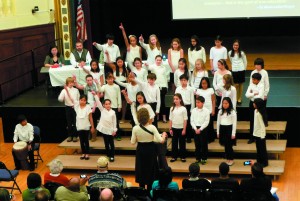
In his remarks, Harris pointed to the challenges around hiring teachers with more diverse ethnic backgrounds in the suburbs, saying that “there is a perception among many minority teachers that suburban school districts are entirely white.” He also said that diversity among accredited teachers in Massachusetts is still very low, making recruiting new teachers difficult. Still, the goal is serious, and Lexington has chosen to participate in an innovative program to increase its success. That program is called Today’s Students Tomorrow’s Teachers (TSTT). Together with Arlington, Andover, and Brookline, Lexington will enroll five students in an intensive mentoring program for prospective teachers. After completing the program at the high school level, students receive a 50% reduction in college tuition to enroll in a program to receive their degree and teaching accreditation. Once students graduate and receive their license, they are eligible for a job in one of the participating districts.
This is just one in a long history of efforts to embrace and celebrate diversity in Lexington schools. Each panelist made a short presentation to the assembled audience and talked about their experiences with diversity issues in life and in the Lexington schools.
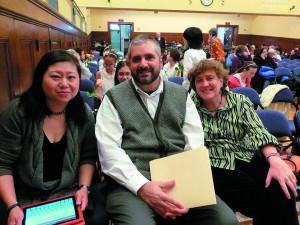
ANN KIM TENHOR
Ann Kim Tenhor, a Lexington High School graduate and an Instructional Technology Specialist in the Lexington schools, remembered her youth in Lexington in the 70s. She said that she felt that Lexington really celebrated individual differences and that really stuck with her. When she went to college, she realized that other students hadn’t had the same experience where they were from. She jokingly said that she was “shocked” to find out that all other schools didn’t host “a multi-cultural potluck dinner!” Throughout her career, Ann knew that she was always seeking to recreate her Lexington experience where she says, “We discuss and share!” In the schools, she is proud to create differentiated learning to address the needs of every student. “Everyone has something to share and something to learn,” she said.
BILL COLE Bill Cole, also an LHS grad, was used to being in places where white folks were in the minority. His family moved around a lot before they settled in Lexington in 1968. Cole said that in his 1981 LHS graduating class, METCO students were being accepted into top-echelon colleges like Brown, Duke, and Harvard.
Fast forward to 2007, and Cole was a Dean at LHS when former Diamond teacher Vito LaMura released his report, “The Achievement Gap in the Lexington Public Schools,” which was generated in response to evidence that Lexington’s METCO students were performing at lower levels than their classmates.
Following up on one of the numerous observations and recommendations in the report, Superintendent Ash created the Achievement Gap Task Force (which later became the Equity and Excellence Committee) and Dean Cole joined. Cole then helped to organize and run a new mentoring program called METCO Scholars which was modeled on a program he had found in Shaker Heights, Ohio. “We’re currently working with our fourth cohort,” Cole explained to the audience. And while he labels their success as “fairly modest over the years” he also said, “we’re aiming high, but not taking any of the smaller objectives or ripple effects for granted.” Cole said that he feels the METCO Scholars program has helped METCO students get “over the hump” in terms of “respective and productive behavior and achieving at a higher level.” Now in the classroom full-time, Cole is inspired by his students. “I think the Lexington High School Community has an incredible diversity of thought,” he said. “I’m incredibly proud of what we are doing in the school.”
MALIK ALFRED
METCO Scholar Malik Alfred would make anyone proud. Malik is a second generation METCO student—both his mom and his aunt attended Lexington schools!
Lexington has been part of Alfred’s life since the 2nd grade when he started on the demanding path of a METCO student. He said, “My experience in METCO has been great,” but he admitted that it wasn’t easy. Getting up every day at 5 AM to catch a bus to Lexington was not easy. “It was challenging coming to Lexington from the Boston Public Schools,” he said. “At that age, I knew that it was different—[there were] definitely fewer people in my class that looked like me.”
Alfred talked about feeling “a little out of place and alone” but said that as he became more involved in the community, “Lexington opened my eyes to…different races and nationalities and lifestyles.”
Alfred also talked about how important it was for him to have the “help and support” of his mother, saying that he was “so blessed and thankful for her.” METCO parents sacrifice tremendously to have their children participate in the program.
Also crucial to Alfred were his host families over the years and especially Kim Hogan, his host “mom” while he was in high school. “She’s honestly the most non-judgmental person,” he said and thanked her and her family for helping him succeed.
Currently, Alfred is attending Dean College and studying criminal justice. “I want to make a name for myself in the criminal justice field,” he said. “I have a dream and that’s my dream.”
MELISSA BUTTARO
Lexington High School guidance counselor Melissa Buttaro said she “found her niche” when she came to Lexington. After several less than satisfying assignments in other districts, she was invited to interview for a position at the high school and said, “I’ll never forget walking across the quad and seeing a rainbow flag hanging in the window above the main entrance in the old health teacher’s office, “safe zone” stickers were visible, my interview committee was diverse, and the questions they asked me included issues of diversity.”
Butarro has been involved in diversity groups everywhere she has worked and is currently GSA (Gay-Straight Alliance) adviser at LHS. She reflected on her own awareness of diversity issues by saying, “Being female, I observed discrimination against girls as long as I can remember.”
As a strong advocate for the GLBTQ community at the high school, she has known her share of controversy but is thankful for the “unwavering support and encouragement” that she has received from the district. Buttaro ended her comments by stating: “We are always trying to do more…it is humbling work. I love it!”
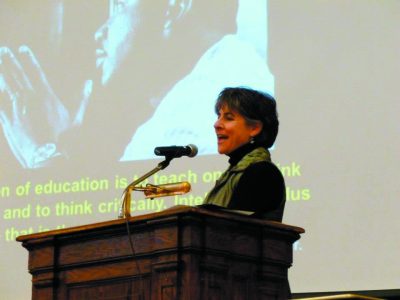
PROVOCATIVE QUESTIONS
In the final moments of the program, audience members came to the microphone to ask questions and made several astute observations.
A young Lexingtonian who attends a private high school in Cambridge said that Lexington was a “stark contrast [less diverse] to my community in Cambridge.”
Another audience member who was involved in the fair housing movement in Lexington in the 1960s observed that “We’ve got a lot of Asian families and a lot of Indian families, but I don’t even think there are as many black families [in Lexington] as we had in 1960.”
A gentleman with a daughter of mixed race expressed concern over the “self-segregation” that he sees among the high school students. He said that he sees it downtown and in the pictures in the yearbook—Asian students with other Asian students, black kids with other black kids, and white kids with other white kids. In classes, they are together, but they are separate when they socialize. “I was most struck by it walking through the high school cafeteria—Commons I and Commons II,” he said.
The answers to these questions and observations are vexing. How do we make Lexington more attractive for black families? How can we encourage more economic diversity in our community? Are diverse groups just coexisting, or are they truly engaging with one another? As the program closed, Jill Smilow encouraged people to reach out to someone new. She commented, “The work is not done, but it’s happening. It’s also imperative.”
Click the link below for more information.
Lexington Metco
